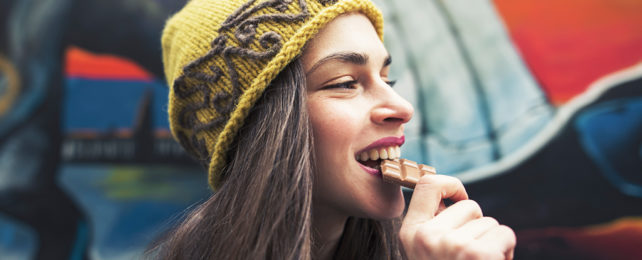It's not just the flavor of chocolate that titillates our senses. The smooth texture of the sweet is also a big part of what keeps us coming back for more.
The combination of cocoa, sugar, and fat is absolute perfection, but unfortunately, these ingredients have their health downsides.
Researchers from the University of Leeds in the UK have now proposed a new way to make chocolate less fatty without sacrificing its smooth texture.
The suggestion is based on how an artificial 3D tongue receives a luxury chocolate bar.
When the robotic mouth part was introduced to four different samples of dark chocolate, researchers found the fat content on the outside of the bar coated the tongue in melted goodness.
If this applies to a human mouth, then the fat content hidden in the body of a chocolate bar may not make much contact with the tongue or the cheek before it gets mixed with saliva and slides down our throats.
The tongue was tested on chocolate bars with four different fat, sugar, and cocoa compositions. Cocoa content ranged from 70 percent to 99 percent. Ultimately, the bars with a higher fat content lubricated the 3D tongue better.
What's more, when fatty chocolate stuck to the tongue, it released cocoa particles right against the tongue's taste buds.
Zooming in on a model of a single tongue bump, known as a papillae, the researchers noticed a similarly sticky phenomenon.
The authors acknowledge that their tongue model is simplistic and might not translate to an actual human mouth. Nevertheless, they postulate that "the lubrication of surfaces in the single-papilla-scale is governed by a bridging effect of cocoa butter in between the cocoa particles… "
In other words, the more fat surrounding a chocolate bar, the more likely it is to stick to the tongue and inner cheek.
"If a chocolate has 5 percent fat or 50 percent fat, it will still form droplets in the mouth, and that gives you the chocolate sensation," explains nutrition scientist Anwesha Sarkar.
"We are showing that the fat layer needs to be on the outer layer of the chocolate, this matters the most, followed by effective coating of the cocoa particles by fat, these help to make chocolate feel so good."
Practical studies now need to be done to see whether creating a low-fat chocolate bar is possible while still maintaining the product's texture and flavor.
The current study did not examine how fat content impacts the taste of chocolate, but fattier chocolate may trap cocoa against a person's taste buds, enhancing the flavor.
The authors hope their results can be used to create a next-generation chocolate bar that's healthier than ever before but still just as yummy.
"We believe dark chocolate can be produced in a gradient-layered architecture with fat covering the surface of chocolates and particles to offer the sought after self-indulging experience without adding too much fat inside the body of the chocolate," the team concludes.
We hope they're right.
The study was published in ACS Applied Materials & Interfaces.
